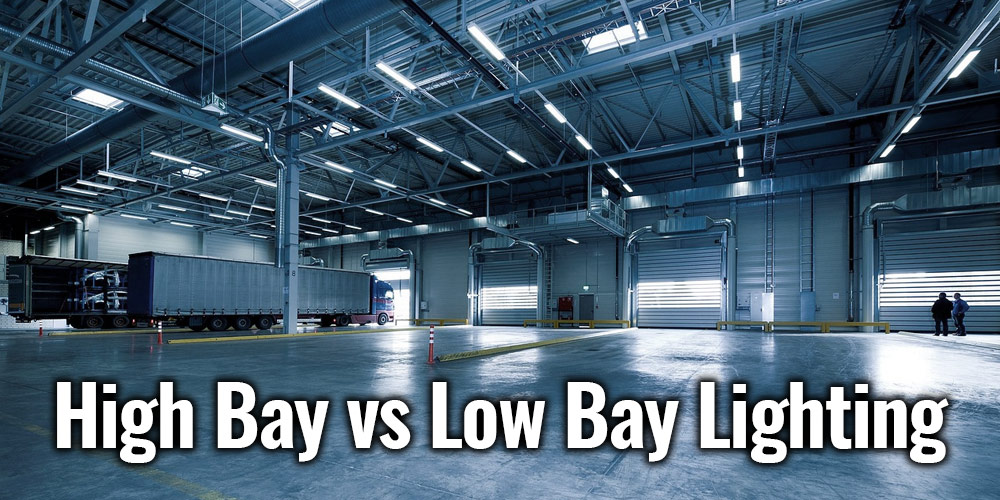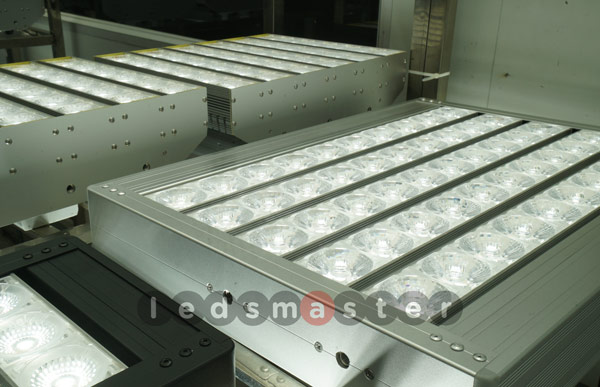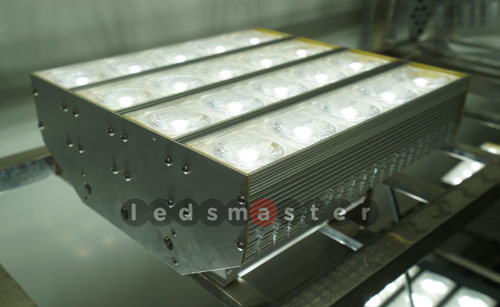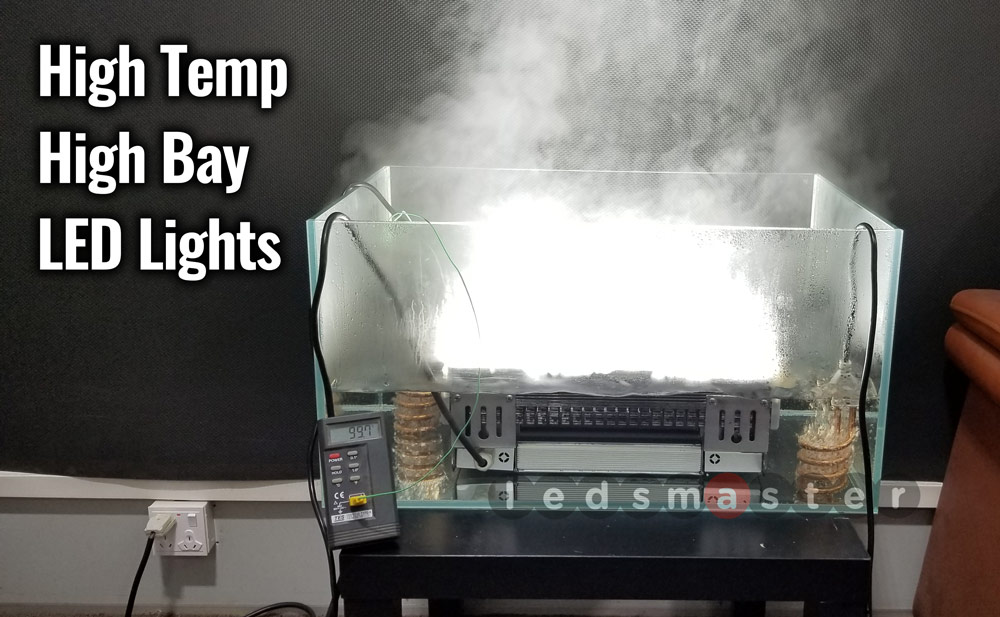
In the world of lighting, there are a lot of terms associated with different fixture types. The difference between high bay and low bay lights is often difficult to understand. A lot of people worry about the negative impact a wrong choice may have in their homes. And they are actually right. Although the final result will not be that bad per se, it will definitely have an overall negative impact on the whole space.
For this reason, being able to identify those two types of lighting and knowing when to use each is vital for every homeowner. Here is an overview of high bay vs low bay lights, their uses, similarities, and differences.
What exactly is high bay light and which types of it are available?
 As the name itself reveals, high-bay lights are a certain type of light that can be used to illuminate places with high ceilings. What exactly is considered a high ceiling? Normally, every ceiling with a height that ranges between 20-45 feet falls into this category. Since a high-ceiling room has more space to fill compared to a lower one, high bay lights are made to be powerful and able to lighten up large spaces.
As the name itself reveals, high-bay lights are a certain type of light that can be used to illuminate places with high ceilings. What exactly is considered a high ceiling? Normally, every ceiling with a height that ranges between 20-45 feet falls into this category. Since a high-ceiling room has more space to fill compared to a lower one, high bay lights are made to be powerful and able to lighten up large spaces.
When we wish to set up a high bay light, there is a series of fixtures we can choose from. LED lights, fluorescent lights, high-pressure sodium, induction and metal halide lights are the more common choices on the market. The style of the lamp that can be used with a high bay light offers customers a series of choices, as well. Linear high-bays, round, as well as grid-mount, are all available options. The specific type of high bay light you wish to use depends mainly on your personal tastes, room space and type of tasks you’ll be performing under it.
What is low bay light and which are the prominent types on the market?
 Low bay lights are another popular type of lighting that’s specifically used in order to illuminate spaces with lower ceilings, ranging between 12-20 feet above the floor. When someone asks to purchase a low bay light, then he will typically have a place with a ceiling that has a height below 20 feet. Low bay lights come in a variety of types, with the most popular ones being the following: compact fluorescent lights, troffer-styled ones, as well as the newest LED ones.
Low bay lights are another popular type of lighting that’s specifically used in order to illuminate spaces with lower ceilings, ranging between 12-20 feet above the floor. When someone asks to purchase a low bay light, then he will typically have a place with a ceiling that has a height below 20 feet. Low bay lights come in a variety of types, with the most popular ones being the following: compact fluorescent lights, troffer-styled ones, as well as the newest LED ones.
Standard and round low bay lights, that possess either prismatic or aluminum reflectors are some other choices.
See also: Best low bay lighting buyer’s guide
When should we use high bay lighting?
The most deciding factor you should take into account in order to decide upon using high bay lights is the height of your ceiling. Any ceiling with a height bigger than 20 feet from the floor requires some high bay lights. If you accidentally use another type of lights in such places, like low bay lights, then the room will probably not get illuminated sufficiently and closer to the floor, a somehow shadowy appearance will get created.
There are certain types of buildings that typically require high bay lights due to their high ceilings and large spaces. Generally, every large indoor space that needs to be illuminated, can use some high bay lights. They are able to cover both horizontal and vertical spaces.
Where to use high bay lights?
High bay lights have multiple applications that are a lot different from each other. They can be used for both industrial and commercial applications. Some of the most common places we may find this type of light are the following: workshops, assembly lines, airports, factories, as well as gyms and large recreational spaces. Other places where we can normally find those lights are warehouses and large storage aisle.
Event centers, large conference rooms, hangars, and other large buildings are also, ideal candidates for those lights. Depending on the type of space you wish to install those lights, the fixtures and specific types of them change a lot. Also, the exact spot of placement can make a whole lot difference to the final illumination results. For example, in warehouses, appropriate fixtures are required in order to light up apart from the ceiling, the aisles and corridors of it, as well.
When should we opt for low bay lighting?
As mentioned before, low bay lights are ideal for low ceiling spaces that can be properly illuminated with smaller and less powerful sources of light. Low bay lighting is the most common choice when we talk about ceilings with heights ranging between 10 to 20 feet. Lens angles are used to further spread the lighting, as well. In fact, those lens angles can redirect the light in specific places.
Although low bay lights can be used in outdoor spaces, there are also, multiple indoor applications. Let us have a closer look at the most common ones!
Where to apply low bay lights?
Low bay lights are ideal for illuminating every tiny interior space, including rooms of a household, offices and public buildings, like hospitals or stations. Various small warehouses, garages, working areas and shops are also, good candidates for this type of light. Generally speaking, every type of place that has a lower ceiling and where ample lighting is required can be the best option for choosing a low bay light. If your area has the tough environment, we will even need the high bay lights that resist the high temperature. Those luminaires have the special protective design and reinforcement for harsh environment.

Types of high bay vs low bay lighting
When you set up high bay lights, you can choose from a variety of different types, each of which has its own features and benefits. A modern and highly-appreciated type of high bay fixture is the LED lighting. Those lights have the biggest life span and they are also, extremely energy efficient. Induction lights are also, quite popular and they use no electrode, therefore they are also, capable to last for many years, as well. Another traditional choice is metal-halide lights. Those lights can be really beneficial for high-intensity applications, including the illumination of a gym or athletic center.
Fluorescent lights are also, quite useful, thanks to their combination of low-cost maintenance and high-lighting performance. Apart from those types of high bay lights, there are also, different shapes and colors of them. For example, homeowners can choose between round, linear or grid-mount high bays depending on the specific needs of their place and their personal taste.
High bay lights also, need specific reflectors or lens angles to ensure that the light reaches the floor of each space evenly. The two most widely used reflectors that accompany high bay lights are prismatic and aluminum. Aluminum reflectors force the light to go straight to the floor, while prismatic ones create a somewhat diffused lighting. That is particularly useful for illuminating elevated objects in your space, like shelves.
Low bay lights are also, available in various types for you to choose from. There is always the option of a modern LED low bay light that offers the extra benefit of high-performance and energy-efficient nature. Compact fluorescents lights that have a long history in the world of illumination of small spaces are also, a great option.
Customers may also, choose between standard and round low bays, that have aluminum or prismatic reflectors and are available in a variety of different colors. Each type of reflector has its own features and offers different benefits, as mentioned above.
How to select the best high bay and low bay lighting
Choosing the best high bay and low bay lighting can make a huge difference to the final lighting result of each space. Apart from choosing between those two major types of lighting, that’s mostly based on the height of the ceiling, homeowners should then go for the specific subtype that matches their building’s needs the most. As we can well understand, a light designed for a storage room or warehouse is totally different from a light used in a gym or factory. Therefore, in order to select the best type of either low bay or high bay lights, we need to take some important factors into account.
1. Beam angle
The beam angle is going to determine the spread of the light and its ability to illuminate the whole space. When the beam angle is narrow, then a more focused lighting reaches the floor or the platform. On the other hand, a wider beam angle allows large open areas with lower ceiling heights to receive a satisfactory spread of light. For this reason, a 40-90 degrees beam angle is normally preferred for commercial lighting, while bigger degrees, that can even reach the number 120 or 150 are particularly good for low ceiling public spaces, gas stations or garages.
2. Fixtures shapes
Both high and low bay lights can be found in a series of fixtured shapes. Each type has its own benefits that are both aesthetically important and functional, as well. The most traditional type of fixture for both categories of lights is the typical pendant-style looking light that is outfitted with a reflector. This type of lighting is not the most energy-efficient one you can find nowadays, and it is also, quite old-fashioned. A more compact and modern solution is the new round high and low bay that are usually IP65-rated and therefore, they can be used in even harsh conditions, like industrial laundries.
If you wish to create a perfect, even light distribution, then you could opt for a linear aisle light. A common application of this type of light is between the warehouse racks in order to light up the walkways.
3. Energy-efficacy
Energy-saving is among the most important factors we should take into account when we have to choose between all those available lighting options. Although it is true that the new LED generation of high and low bay lights are among the most energy-efficient, there are other available options, as well. For example, the new-generation fluorescent lights can sometimes provide a better performance, at a similar energy-saving rate to LED.
Overall similarity and differences between high and low bay lights
A lot of homeowners are quite confused about the differences between high and low bay lights. When we wish to compare those two types, we can find at least one major similarity: they are both specifically designed to illuminate large spaces. The word ”bay” itself in the lighting industry refers to exactly that: the ability of those devices to light up different types of spaces. Therefore, both types have some similar applications, and they can be installed in similar places, including warehouses, garages, factories, and houses.
Another significant similarity between them is the fact that they are both mounted at a high level with the use of a cord, pendant or chain. They can also, get installed directly onto a ceiling or ceiling girder.
Despite that similarity, however, high bay lights are a lot different compared to low bay ones. As we mentioned before, the most important difference between those two types of lights is the fact that they are used for different room sizes, depending on the height between the floor and the ceiling. High bay lights will typically have a beam angle of 90 degrees or lower. Their power is often more than 150W. On the other hand, a low bay light will normally have a beam angle of 120 degrees or even 150 degrees. Their power range is typically between 60-100W.
In terms of technical differences, those two types of lights have at least one major one: lumen output. Low bay lights will normally require less lumen output because they tend to lose less light. The high lumen output of a high bay light is usually associated with the greater distance this type of light has from the floor. That makes high lumen output necessary in order to prevent the creation of shadows and to allow the light to reach every small spot in the room.
It is true that high and low bay lights may share some common ground, but they are actually quite different. Being able to identify the one your property is in need of is vital in order to achieve some good and even final lighting experience. In any other case, you run the risk of having to remove the whole installation afterward when some problem, like the appearance of shadows or glares, affect your ability to enjoy the lighting of your space.
